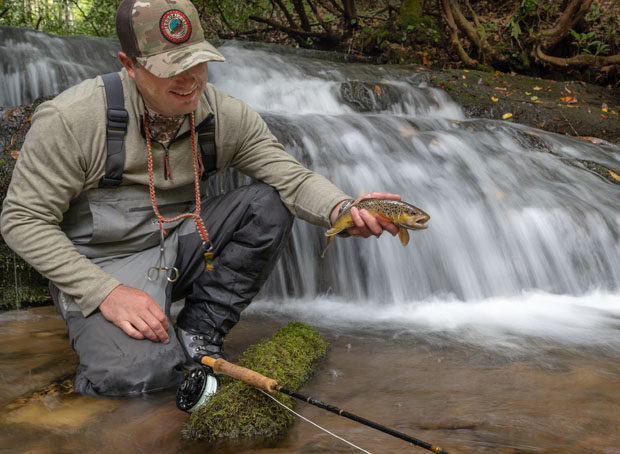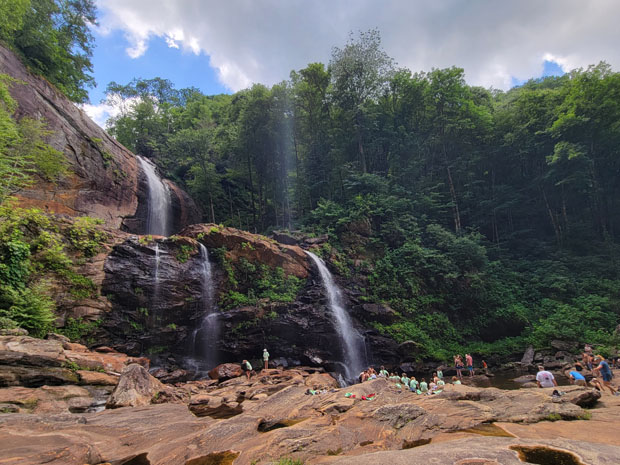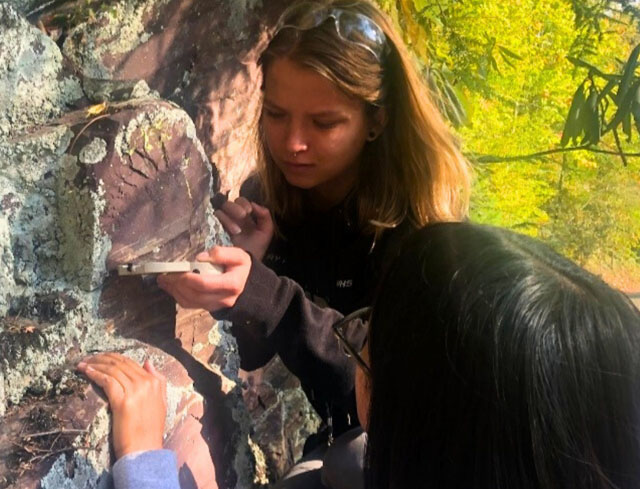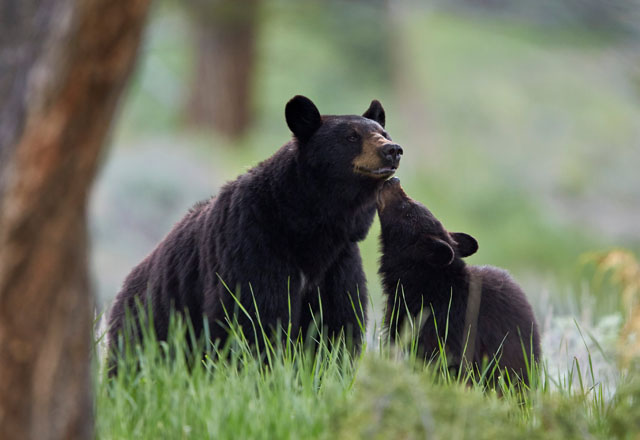The Evolution of Our Local Waterways
05 Apr 2023
Cashiers Historical Society’s Jan Wyatt Symposium delves into the history and future of fly fishing in the southern Appalachian Mountains
Story by Brendon Voelker
Photos by Matt Canter

Fresh mountain water gallops along ripples in the granite as it slowly drains into one of the area’s more secretive fishing holes—one few locals are quick to tell you about. Southern Appalachian brook trout rest quietly along rocky shoals where the currents help oxygenate the water. “Foam is home,” Rob Lilley of Davidson River Outfitters states as he lines up a cast towards the bottom of a cascade. With the flick of a wrist, his purple dry fly lands and begins to drift alongside the current.
After hours of searching for one of the area’s most elusive fish, I choose a collapsible Tenkara rod as we move into tight spaces along smaller creeks. Just a few casts in, the rod tip bends as I hook the first catch of the day. At just 4” long, it may not be the “trophy” fish you’d expect to find, but its ability to survive intense flooding, destructive logging, modern developments, and invasive species shows the wonder and resilience of the southern Appalachian brook trout. Interestingly, casting a line at this topic may prove more difficult than catching a fish itself.
There are no trophy fish. “Each catch is a reward,” says Chris Franzen of Headwaters Outfitters. Lead guide of Rosman’s most prestigious outfitter for eight years, Chris has been fishing since he was just three years old. An expert on most rivers and streams in Pisgah National Forest, he also enjoys the thrill of fishing for stripers, smallmouth, and brown trout in our local waterways, yet he reminisces on reeling in a 48” muskie out of the New River some-15 years ago. If you ask him about his favorite spot, it’s unlikely you’ll get an answer because “any spot where there’s nobody around” is always his favorite.
About 20 miles up the mountain towards the Highlands-Cashiers Plateau, Matt Canter of Brookings shares a similar story. He began fishing at the age of 11 and enjoys all facets of the sport. To date, his largest catch was a 125-pound tarpon on the coast, which he describes as an “adventure” and laughs sheepishly. The solitude is just as important to him, but he also notes how the sport “takes you to places you likely wouldn’t otherwise see.” You can discover our local backcountry, wilderness, or explore remote parts of the world in search of any fish you could imagine. He deepens the conversation by explaining how some rivers are “bug factories,” while others tend to yield more baitfish. The nuance of his knowledge is both incredible and inspiring.
For all acclaimed river guides in the region, one thing is clear: Western North Carolina is one of the most coveted fly-fishing destinations in North America. Areas around Panthertown Valley, the Davidson River in Brevard, or even the Chattooga River offer highly desirable fishing for guides thanks to their consistency. Made famous by the 1970’s movie, Deliverance, the Chattooga remains an iconic north Georgia river known for its kayaking, fishing, hiking, and more.
A presenting speaker at the 2023 Jan Wyatt Symposium in Cashiers, Matt elaborates on our local trout as he condenses them into three categories: native, wild, and hatchery. According to biologists and historical records, it’s surmised that the southern Appalachian brook trout is the only native species to our mountain streams in western North Carolina and remote parts of upstate South Carolina. A somewhat rare species to stumble across for the average angler, they were deemed the official freshwater trout for the state of North Carolina in 2005.
Wild fish include introduced species such as rainbow and brown trout, smallmouth bass, and others that have established themselves in our rivers and can reproduce naturally. For botanists, the term “naturalized” would be a relatable topic when referring to these species. Similar to the day lilies you see along the road in the summer, they are not native, yet they are not considered invasive.
Hatchery supported fish, however, may be one of the most intriguing topics. In recent years, many of our local hatcheries have switched to genetically modified fish that are sterile and unable to reproduce. Known as triploids, it is a common practice with a variety of hatchery-raised fish. While the sterility may seem odd to the average reader, the process reduces the environmental impact of fisheries management and can even yield larger fish sizes for recreational anglers. Without hatcheries, we wouldn’t have prized fishing waters; yet these fish develop a taste for smaller brook trout in areas where their habitats overlap.
Though we host some of the best fishing in the southeast, it has been a tumultuous journey to make it happen. Cold mountain streams once bursting with fish are now threatened by major reservoirs and low-head dams. From a distance, their impact seems minimal, yet the standing water above the dam creates a rise in water temperature that isn’t conducive for brook trout. Pair that with the decline of the eastern hemlock, an evergreen tree species that thrives along rivers and streams, and you can begin to paint a picture. The decline of fish habitats isn’t tied to one variable; it’s an equation that must be addressed from every angle.
The depth of these topics has been the lifelong focus for some, and Cashiers Historical Society’s Jan Wyatt Symposium hopes to cast light on the history and evolution of our local waterways. Leading experts in the field will be there for a one-day event presenting topics ranging from traditional rod and reel setups to modern conservation efforts of native species.
For 2023, the symposium is titled “Talking Trout” and boasts a heavy focus on the history of fly fishing across the southern Appalachian Mountains, especially around Cashiers and Highlands. A one-day event, respected speakers will focus on fish species, healthy waterways, fisheries management, current threats and more.
During the afternoon, participants will have the option to experience one of many hands-on activities accompanying the event. According to Dennis Chastain, a local expert on fly fishing and one of the main presenting speakers at the symposium, there is something for everyone in the family to enjoy, and both novice and seasoned anglers will find value in the presentations.
Now retired and living in upstate South Carolina, Dennis is a walking encyclopedia when it comes to native and non-native species. Current author of a bi-weekly article in the Greenville Journal, he has spent decades panning through historical documents, speaking with landowners, and theorizing how certain fish became introduced and naturalized in our streams.
One of those stories includes evidence that General Wade Hampton III transplanted fish across the eastern continental divide near his property in modern-day Cashiers. Other deep dives into the topic include confusion between common and scientific names, habitat decline, and why he favors fishing small streams on the South Carolina side of the border.
Organized by Maggie Elmer of the Cashiers Historical Society (CHS), the event will be held Thursday, June 15th at the Canyon Kitchen in Lonesome Valley. Beginning June 14th, a month-long native trout exhibit will also be available at the Zachary-Tolbert House in Cashiers.
The CHS Jan Wyatt Symposium would like to extend a special thanks to McKee Properties, Brookings Anglers, Lonesome Valley, and Maggie Elmer for facilitating the event. Tickets are $100/per person and available to purchase online at cashiershistoricalsociety.org or by emailing maggie@cashiers.com.













